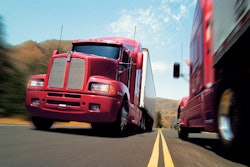Seattle: Kirk Altrichter, vice-president of maintenance for Seattle-area based Gordon Trucking knows a thing or two about fuel efficiency and rising fuel prices.
“Fleets are always looking for ways to control fuel costs, especially as fuel prices increase and fuel surcharge lags behind," Altrichter says.
Gordon Trucking, which runs 1,700 power units and is the 24th largest truckload carrier in North America, is open to new technology and fuel savings devices, “but they have to prove themselves in our fleet operations,” Altrichter says.
“One product with proven payback is the Freight Wing Aeroflex trailer side skirts,” he says. “It’s led us to begin installing 2,000 additional sets on our trailers. These will join the 2,200 plus trailers installed with the Freight Wing side skirts already in the GTI fleet. During our testing, we saw a 0.3 mile per gallon improvement, and that gives GTI a payback of less than 18 months.”
In reality, that ROI is even less now – it was originally calculated when fuel was at $3.25 a gallon.
With $3.80 for diesel as a benchmark price, GTI will save approximately $2.2 million a year in fuel costs with side skirts. If the fleet were completely outfitted, that number would rise to about $4.5 million per year, while saving more than 13,000 tons of CO2 annually.
Altrichter began conversations and testing with Freight Wing almost seven years ago. “Intuitively we saw the value in the Freight Wing concept and we were willing to work with them on testing. The first prototype didn’t last long, but they took our input on improving the product’s durability. Eventually they came up with the Aeroflex, made of flexible automotive-grade plastic, that we feel really works well in our industry," he says.
"Over the years, we’ve also tested other brands, which used fiberglass and aluminum for their fairings. With fiberglass, we saw some problems with scraping the bottom edge in low clearance situations," says Altrichter. "It caused the fibers to fray and allows moisture to seep in which ultimately causes delamination in the panels and product failure. With metal side skirts, they work if you don’t bottom out, or hit anything. But, that’s not the real world.”
With the Freight Wing side skirts, Altrichter says Gordon Trucking expects a 10-year life cycle because of the quality of construction and brackets that allow the skirts to flex.
According to Sean Graham, president of Freight Wing, all the homework the company did in the early years paid off.
“Before our first sale was ever made, we worked hard to prove the theory of trailer side skirt aerodynamics and fuel economy improvements,” he says. “Through SAE/TMC standardized track testing, we verified up to a 7 percent improvement in fuel economy with our side skirts. In the real-world, we’re seeing that translate to a 4 to 6 percent improvement for our customers depending on their operations. That results in a fast return on investment, even for fleets like Gordon that have large trailer to tractor ratios.”
For Gordon Trucking, the standardization of side skirts on its two-axle trailers is a further commitment to reduce its carbon footprint and dependence on foreign oil. “And, it’s simply good business,” says Altrichter. “We were an early adopter of fuel efficient components and joined SmartWay in 2004. We run aerodynamic Freightliner tractors with rear cab spoilers and under fuel tank skirts, have low rolling-resistant tires, operate tire inflations systems, run APU’s on the vast majority of our long-haul tractors to bring idle time down to 3 percent, and utilize the Freight Wing side skirts. Combined, it’s giving us an edge in fuel economy.”
The company’s dedication to safety, customer service, fuel savings and its reduction in its carbon footprint has been recognized throughout the industry. Gordon Trucking has been a multi-year recipient of SmartWay’s Environmental Excellence award; ConAgra’s 2009 Innovation Transportation Partner of the Year; The Truckload Carrier’s 2010 National Fleet Safety Award, and The Washington State Trucking Association’s 2010 Grand trophy (fourth consecutive year).


















